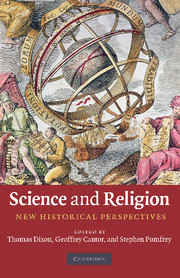Book contents
- Frontmatter
- Contents
- List of contributors
- Preface
- 1 Introduction
- PART I CATEGORIES
- PART II NARRATIVES
- 4 Religion and the changing historiography of the Scientific Revolution
- 5 The late Victorian conflict of science and religion as an event in nineteenth-century intellectual and cultural history
- 6 Islam, Christianity, and the conflict thesis
- PART III EVOLUTION AND CREATIONISM
- PART IV THE POLITICS OF PUBLISHING
- PART V WAYS FORWARD
- Select bibliography
- Index
4 - Religion and the changing historiography of the Scientific Revolution
Published online by Cambridge University Press: 05 May 2010
- Frontmatter
- Contents
- List of contributors
- Preface
- 1 Introduction
- PART I CATEGORIES
- PART II NARRATIVES
- 4 Religion and the changing historiography of the Scientific Revolution
- 5 The late Victorian conflict of science and religion as an event in nineteenth-century intellectual and cultural history
- 6 Islam, Christianity, and the conflict thesis
- PART III EVOLUTION AND CREATIONISM
- PART IV THE POLITICS OF PUBLISHING
- PART V WAYS FORWARD
- Select bibliography
- Index
Summary
The notion of the ‘Scientific Revolution’, spanning roughly the period from 1500 to 1700, has served as the linch-pin for historians of science from at least the late nineteenth century, although it did not acquire that name until the 1930s. Encompassing the time between Copernicus and Newton, it has traditionally served as the terminus ad quem for the ancient and medieval developments that preceded it and the terminus a quo for all that followed. According to traditional accounts, this period witnessed the birth of modern science and its attendant methods and institutions. Not itself an explanatory concept, the Scientific Revolution has become the focus for questions that guide historians of science, questions about what it was, what exactly happened, why it happened, and why it happened when and where it did. The past century has witnessed many changes in the historiography of the Scientific Revolution. Yet, as this chapter will demonstrate, there has been a close interrelation between conceptions of the Scientific Revolution and assumptions about the relationship between science and religion. Focussing on the way the Scientific Revolution was defined in the late nineteenth and throughout the twentieth centuries, a period when science and religion were generally portrayed as separate, analysis of the formation of that view and its ultimate demise will highlight the close relationship between changes in the historiography of the Scientific Revolution, on the one hand, and ideas about the relationship between science and religion, on the other.
- Type
- Chapter
- Information
- Science and ReligionNew Historical Perspectives, pp. 71 - 86Publisher: Cambridge University PressPrint publication year: 2010
- 1
- Cited by

